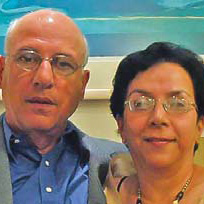
For many decades, the Vale of Kashmir has played hard to get; a fickle lover that sometimes beckons and at other times, petulantly turns away from the beloved. We are unabashed Kashmir lovers. We yearn periodically for a sight of its flower-spangled green meadows and the snowwhipped Himalayas and are overcome by the desire to hoist its apple-cheeked children on our shoulders.
Indeed the northernmost region of the country is buried in the collective unconscious of most Indians as a paradise on earth – at times elusive but always utterly desirable; troubled yet irresistible and gift-wrapped over the decades by Bollywood in its romantic sagas.

In the embrace of a wintery sonata
As we drove from the airport to the Vivanta by Taj, Dal View, Srinagar where we would be staying, we got tantalising glimpses of the town’s heart-stopping beauty. We had expected to see a shell-shocked city, the heart of a battle zone but what we saw were sloping red and green-roofed homes, new lowslung malls, a handful of fast food restaurants – all of it set against an alluring backdrop of muscled mountains and a serene lake. Sadly, the Kashmir valley’s drop-dead gorgeous looks have brought it much misfortune; two countries locked in seemingly eternal conflict in order to possess it completely. However, in the wake of a tenuous peace, Kashmir has become more accessible and the last two and a half years have seen a boom in tourism.

We were in the valley when it was clasped in the embrace of a wintery sonata. We stayed for a few days at the Vivanta by Taj (one of only three luxury resorts in the valley) and later at the Khyber Himalayan Resort and Spa in Gulmarg. The Vivanta by Taj does not stridently proclaim its presence atop Kralsangri Hill overlooking Dal Lake; rather the luxury hotel seems to pull back the curtains to showcase the loveliness of the landscape. On one side of the resort, the Zabarwan Mountains wrestled their way to the sky and below our garden patio, Dal Lake flared like a sequinned skirt… Its still waters were cleaved by colourful shikaras, flocks of wild ducks, floating gardens and bobbing houseboats, fragrant with carved cedar interiors. (The houseboats were built in the 1800s when the British started to seek the cool climes of Kashmir and the then maharaja forbade the colonialists from building or owning houses on land. Even today, only locals can own land in the state.)

Cruise on the Dal Lake
Come evening, we set off on a shikara cruise on a lake that rippled like molten gold while eagles swooped on the thermals above us. We glided in silence, awed by the beauty of it all. Our captain guided his boat along narrow canals lined with colourful shops that sold Kashmiri handicrafts and floating gardens drifted past in a swirl of colour and fragrance. Soon, honey-tongued vendors in narrow country craft had slipped in on either side of our shikara, to try and peddle their wares – saffron, spices, silver jewellery, walnuts, almonds, shawls etal. One boatman had a mobile tea stall aboard his narrow boat. He offered us the local kahwa, brewed in an elaborate samovar placed on a coal stove. The hot kahwa, decorated with strands of saffron, cinnamon and garnished with almond slivers, slid down our throats and warmed us that chilly evening. As the sun took a bow, the amphitheatre of peaks that soared above us was soon awash in post-sunset hues. Along the lakeshore boulevard, edged with sentinel poplars and chinars (maple trees) that poked accusing fingers at the sky, local men in calf-length pherans (a kind of long poncho worn over trousers) ambled along the lakefront. A few groups of pinkcheeked Kashmiri women, arms linked, exuded the freshness of spring flowers. They stopped to ask a bevy of pretty women tourists, walking ahead of us, where they were from. A friendly exchange followed and we somehow felt safe and secure in this once-forbidden city.
Back at the resort, mantled in a velvety dark night stabbed with a million stars, we felt like we were suspended in a realm between heaven and earth.

Strolling in the Mughal Gardens
Early in the morning, the seismic knot of the Zabarwan Mountains thrust into the horizon, their bulging bellies banded with thick swirls of mist. It was the ideal time to visit the Gardens of Shalimar, Nishat and the Chashma Shahi, tiered and landscaped in the Mughal style in a setting of mountains and lake. At the Chashma Shahi Garden, we cupped our palms and drank the crystal-clear water of the mountain spring that is said to be the purest water in Kashmir. Terraced Pir Mahal…the Hazratbal shrine… and the Jama Masjid… Srinagar, Gulmarg and Pahalgam had the white mysterious quality of a fairy-tale realm; the land of Snow White and the Seven Dwarves! Early one morning, we drove to Gulmarg via Tangmarg, 53 kms away from Srinagar. Most tourists stop at Tangmarg to switch to four-wheel drive cars or cars with chains on their wheels to increase traction on icy slippery roads. Ramshackle shops in Gulmarg rent gumboots and winter wear for tourists unprepared for the weather.

A view from Mt. Affarwat
We drove past dark-green forests of pine that rose from deep secret valleys and snowy mountains that blotted out the sky – well, almost! Snow banks rose along the edge of the road like giant helpings of cream, and in Gulmarg, icicles hung from green-roofed, blond-wood cottages like the fingers of a vampire.
In the vast white bowl of Gulmarg (a green meadow in summer), located 8,825 ft above sea level, bronzed skiers from the West, helmeted and clad in neon gear glided down the powder-white slopes like flying gnats, turning and twisting The Dal Lake takes on a golden hue at sunset Silhouette of Char Chinar trees on Dal Lake at sunset occasionally with unbelievable grace.

Hot Cuisine in a Cool Valley
Memories of Kashmir are always laced with the fugitive fragrance of its spectacular cuisine. Kashmiri food (especially the festive Wazwan banquet) can overwhelm not only one’s taste buds but also one’s other senses!
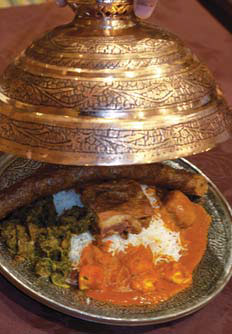
We first savoured this rich cuisine in the home of a local family where kahwa poured from an antique samovar was the overture to a sumptuous dinner that we ate western style. (Traditionally, a Kashmiri banquet is a time of togetherness and is eaten from a round copper tarami or salver and shared by groups of four diners). A line-up of spice-heavy dishes followed in colourful profusion, leaving us satiated and bemused as our hosts explained that what they had served us was just a trailer of around 10 courses. The grand Wazwan or wedding feast comprises 36 dishes – conjured by a Vasta Waza or head chef assisted by apprentice wazas. The number of courses and the lavish scale depend on the hosts’ financial circumstances but families tend to set aside a lifetime’s savings in order to finance this ultimate wedding feast.
The waza’s culinary skills, recipes and trade secrets are inherited from the father and wazas have, over the centuries, acquired iconic status in the valley. In the wedding season from May to October, the skilled cooks are in great demand. According to some reports, after Timur or Tamerlane’s 15th century invasion of India, 1,700 skilled wood carvers, weavers, architects, calligraphers and cooks migrated from Samarkand and other parts of Central Asia to the Vale of Kashmir and today’s wazas are descendants of those master chefs.
We were in the valley this February, after two decades, and memories of that dinner with our friends still buzzed on our palates. Indeed all the fecund beauty of a lovely land is trapped in the cuisine of Kashmir. How can a waza go wrong when he infuses his creations with the subtle flavours of saffron harvested from the region’s many fields; liberally uses the succulent meat, yielded by woolly sheep that graze on green mountain slopes, and makes his gravies blush with the colour and aroma of red-hot chillies and plump tomatoes? Aromatic cinnamon, cardamom and cloves – muted by curd and maval, a dry powder made from cox comb flowers are other ingredients which the Vasta Waza shops for prior to a wedding. Juicy apples, cherries, and plums grow in abundance in the region and cool the fires generated by a robust meat-based cuisine. Then, like the conductor of a symphony orchestra, he supervises the making of every dish – with élan and dollops of magic.
We once again relished a sampling of the Wazwan feast in the glass-enclosed restaurant of Vivanta by Taj, Dal View, Srinagar and at the Khyber Himalayan Resort and Spa in Gulmarg where wrap-around views vied with the luscious cuisine.
Heaving with spices and red gravies that sizzle with meat fat and ghee, this cuisine of Iranian origin may clog one’s arteries but its authentic flavour can only be delivered by the waza, explained Executive Chef Ganesh Joshi as we dipped into some choice dishes at Latitude, the restaurant at the Vivanta. The meal begins with guests washing their hands ceremoniously in a tash-t-nari (an ornamental jug and basin). You cannot break the cardinal rule – you must eat with your hands rather than forks and knives.
On a white dastarkhwan or table cloth are placed large copper tramis heaped with rice and the first few courses including the familiar seekh kebabs, and rishta – the latter are pounded soft meat dumplings in a saffron-infused red gravy. Subsequent dishes follow in a ballet-like sequence, allowing diners to taste each morsel so that the varied tastes pop on the tongue.
The mouth-feel of the cuisine at Latitude was authentic for it was all rustled up by a waza: tabak maaz, marinated lamb ribs deep fried till crisp; mirchwangan korma, mutton in a traditional chili gravy and a cousin of the familiar and fiery rogan josh; dhaliwal korma, chicken cooked in a curd based, saffron-spiked gravy and garnished liberally with coriander; mutton kanti, a home-style dry lamb dish…Large gushtaba, pounded lamb meat dumplings swimming in a yoghurt gravy and garnished with coriander, generally wraps up the banquet. Not surprisingly, a waza is judged by the quality of his gushtaba!
“Indeed all parts of the lamb are used,” explained the Executive Chef “and the waza uses only freshly slaughtered lamb so that the juices are retained. Frozen meat is never used.” The meat is then marinated and cooked in copper cauldrons that simmer over multiple wood fires.
A few vegetarian options are included: Butt haak is local spinach cooked in its juice and tempered with whole chilies; paneer kanti, a dry cottage cheese preparation and the familiar dum aloo, small fried potatoes simmered in a spicy red gravy… An unusual vegetarian offering is the nadru yakhni, locally grown lotus stems in a clove-simmered yoghurt gravy.
If you are having a Wazwan feast for the first time, be warned that in if you wipe your trami plate clean, you will be plied with some more! To douse the spicy fires in one’s tummy, a cool velvety phirni is served as a dessert. In this valley, where beauty is taken for granted, the cuisine too is a colourful strand of the tapestry, The Wazwan, despite the region’s tumultuous past, remains a mouthful of Kashmiri flavours, and an arena where the Vasta Waza plays a stellar role.

We checked into the Khyber Himalayan Resort and Spa where Alpine style meets Kashmir design and this centrally heated resort soon became our haven when Gulmarg’s subzero temperatures chilled us to the bone. The Great Outdoors beckoned and we headed for the gondola, one of the highest and longest in Asia, which bore us up to Kongdoori mountain (first stage), swinging and swaying over impenetrable forests of pine and scarred mountain slopes, heaped with snow drifts. We relaxed at an open-air restaurant near Kongdoori station where we savoured kahwa while the sun’s rays poured over us like streams of warm honey!

Fortified, we embarked on the second stage of our journey to the top of Affarwat Mountain from where we could see the Line of Control and frozen Alpather Lake. We had travelled a total aerial distance of 5 km! Tourists from South East Asia and Indian tourists frolicked in the snow and posed for photographs. On the other side, practised skiers from Europe got ready to take off for Tangmarg, a mountainous forested route laced with a hint of danger. Virtually airborne over snow drifts and pristine slopes, unmarked by trails, they were akin to ski gods in an alien environment… The ski runs varied from 8,700 ft to 14,000 ft, one of the highest in the world.

Take Home a Sliver of Kashmir

IT is a given that people who live in such beauteous environs as Kashmir will have their creative juices flowing like a raging river. Craftsmanship is embedded in the DNA of the Kashmiri – take the soft, warm Pashmina shawl, for instance, woven from the wool of the Pashmina goat indigenous to the Himalayas. This soft-as-a-snow-ball drape is the prized possession of most Kashmir lovers. The Pashmina is a legacy of Zain-ul
Abidin, a 15th century ruler who loved to create things of exceptional beauty and brought in weavers from Central Asia. A single shawl can take five to 12 months to weave and can be very expensive. (Shawls made of Pashmina mixed with regular wool can be cheaper.)

Shawls made of pure Kashmir wool and embroidered with typical motifs are also iconic but much cheaper than the Pashminas and the exquisite Shahtoosh shawls. (Buying and selling of the once prized Shahtoosh shawl is now banned as these exquisite works of art were made from the fleece of the endangered Tibetan antelope.) So soft and fine was the texture that it is whispered that these could be passed through a wedding ring. Indeed the Shahtoosh were testimonies to the nimbleness of the Kashmiri weavers who had for centuries honed their skills with weaving shawls.
Also handmade are Kashmiri carpets, woven to last a lifetime and more. The yarn used could be silk, wool or both and carpets and rugs can be an expensive though worthwhile purchase. The price of a carpet depends on the size, the intricacy of the design and the number of knots per square inch. A rule of thumb is that the higher the knots per square inch, the greater the durability and value of a carpet. Check the reverse of the carpet to gauge the number of knots and also to ensure that the carpet is hand- knotted and not tufted. The markets brim with carved walnut wood items such as bowls, trays, chest of drawers etc., and papier mache doodads. The craft of papier mache is again a 15th century tradition introduced by King Zain-ul-Abidin who invited artists and craftsmen from Central Asia to settle in the valley. Made essentially of paper pulp (sometimes other materials are used as well), papier mache items include pill and jewellery boxes, flower vases, ash trays etc.
Dry fruits and saffron are other must buys in paradise Srinagar’s Boulevard and Lambert Lane are lined with souvenir shops. The Kashmir Government Arts Emporium, located in the atmospheric former British Residency Building, has fixed prices and is a treasure trove of Kashmiri crafts.

We returned to The Khyber in time for High Tea at the Tea Lounge – it was high tea with a Kashmiri twist. There were bite-sized eats – quiche stuffed with a local vegetable; a phyllo pastry encased seekh kebab, phirni in a tart, saffron cheese straws…The rich interiors glowed with the spirit of the land. A vast lobby, with a variety of seating options – comfortable sofas set on rich Kashmiri carpets, ground level traditional seating with silk cushions, a snug Tea Lounge, cigar lounge and a restaurant. The Khyber was almost like a museum with its 20 kg copper samovars, papier mache screens, crewel stitch embroidered silk drapes and exquisite Kashmiri rugs.
We could scarcely tear ourselves away from our mountain view rooms and cameos of soaring peaks that bore their burden of snow with ease and sentinel dark- green pines fracturing the horizon. The pines would occasionally shudder in the cold, as it were, and shake off their load of snow with a rustle and a sigh. We sipped tall drinks on our balcony, shivering in the below zero temperatures but the view made up for the discomfort.

Skiing in Gulmarg
The next morning we walked up to the Indian Institute of Skiing and Mountaineering (a Central Government initiative) headed by the formidable Col Joe Dhillon who has scaled 24 mountain peaks and, in the process, has lost two toes to frost bite!
The colonel has floated highly subsidised adventure courses for the young and the young-at-heart in an effort to convert under-exercised Indians into nimble skiers and mountaineers. The institute itself with its cosy, centrally heated interiors and modern equipment, excellent residential facilities and cafeteria is becoming increasingly popular and courses fill up quickly, he told us, as youngsters now realise that Kashmir is as safe as any other destination in the country. Indeed the colonel is very optimistic that the valley will once again draw tourists like it did before the insurgency and become the country’s premier destination.

We had a skiing lesson scheduled with a ski instructor that morning as one can even enroll for basic ski lessons for a day or two. After mastering the art of clipping on the special ski shoes and strapping on the skis, the nuances of balancing on them, moving sideways and then forward, slipping, falling ….we were able to do a few feeble turns near the institute. However, helmeted young toddlers on miniature skis were soon skimming the slopes like tiny professionals who had skied all their lives!
Young Indians were trying their hand at skiing; some were snowboarding while others drifted away in a hot air balloon like giant exotic birds. Sheer lack of skill prompted us to cut short our ski lessons and we retreated to the institute for some hot coffee.
Later as we swung up once again in the gondola, skiers from overseas raved about the beauty of Gulmarg and the fact that the facilities were cheap compared to stylish European ski resorts. “The slopes and the powdery snow are superb,” said members of a group of British skiers who were getting ready to glide off through the forests towards Tangmarg. Others were happy that the slopes were not crowded with experienced skiers – an irritant that they encounter on the swish chi chi slopes of Europe. German, French and Australian accents mingled with Hindi and Gujarati in a happy melee. We, however, were content to stand atop Mt Affarwat, feeling one with a glistening world of white where snow packs balanced on pine tree branches, the ski slopes undulated in the distance resembling unending trails of castor sugar and mountain peaks snarled at us for invading their domain.
Awed by nature’s largesse and her magnificence, we returned to our resort, feeling insignificant and small in the larger scheme of things.

Pahalgam – The Valley of Shepherds
Yes, Gulmarg was alluring but our first sight of Pahalgam or the Valley of Shepherds, a few days later, elicited a breathless “wow.” Pahalgam, located in a valley by the Lidder River, had the enigmatic air of a snow-bound village – embraced by pine forests and surrounded by snow-capped peaks. Pahalgam’s hushed valleys like the Betab and Aru were serene bowls of cream in winter where we tumbled in the snow watched by an amused shepherd, zipped around on a sledge pulled by a muscled local and breathed in the sharp crystal-clear air by the lungs full. The sound of the skipping blue Lidder, half frozen in places, was like a continuous lullaby and was interspersed with the calls of jet-black ravens that seemed precariously balanced on bare-branched trees.

Driving back to Srinagar, 96 km away, we passed pretty friendly children who waved goodbye. A four-year-old child, returning home from school with her wizened grandfather, waved us to a stop. We handed her a bunch of grapes which she accepted with a grateful “Thank you.” She added with a smile, “My name is Muskaan. Where are you from?”

A short conversation later, brimming with the warmth of the people of the valley, we drove on to the Vivanta by Taj in Srinagar to spend our last day and night in Kashmir. Quiet reigned and its touch was feather-light in a valley that for 20 years had been torn by rage and strife; and historically has been a soft target of passing invaders.

Kashmir today seems to have finally found its road map to peace – hopefully a lasting one, allowing us to return again and again to this paradise of breeze-rippled lakes, lush, terraced Mughal gardens, flower-spangled meadows and snow-stunned peaks.
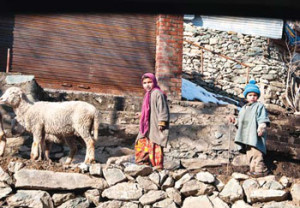
Fact File
Kashmir is a year-round destination with each season showcasing a different facet of the valley. In winter snowcuddled mountains and valleys and half frozen lakes and rivers take centre stage while spring and summer blaze with colour. In autumn, the landscape is tinged with gold and shades of rust.
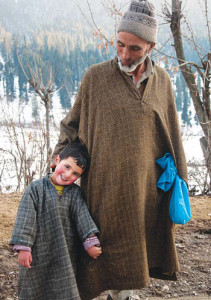
Getting There
Srinagar is the nearest airport and well connected with flights from Mumbai and Delhi. The nearest railhead is Jammu Tawi (305 km) and one can also drive from Jammu to Srinagar.
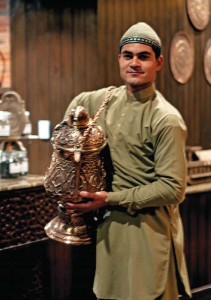
Where to stay
While Vivanta by Taj, Dal View, Srinagar, combines luxury with unsurpassable views, The Lalit Grand Palace is a slice of history. There are a number of mid budget and budget options as well. And no visit to Srinagar is complete without a night in a houseboat.
In Gulmarg, The Khyber Himalayan Resort and Spa is the top of the heap while there are others like the modest oldworld Highlands Park.
Hotel Himalaya House and Hotel Brown Palace are options in Pahalgam.
Contacts
J&K Tourism: www.jktourism.org
Vivanta by Taj, Dal View, Srinagar: www.vivantabytaj.com/Dal-View-Srinagar/Overview.html
The Khyber Himalayan Resort and Spa, Gulmarg: https://khyberhotels.com/



